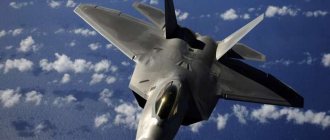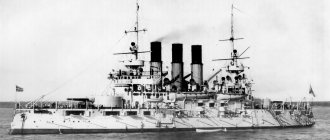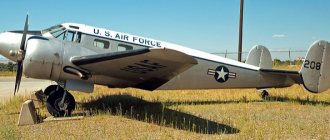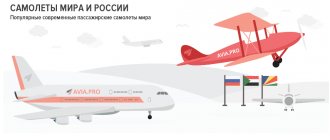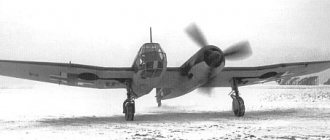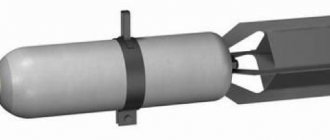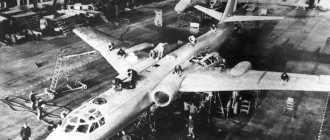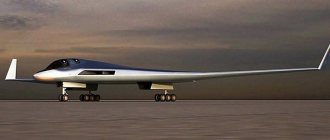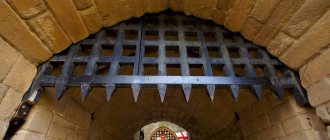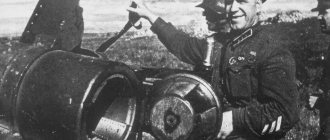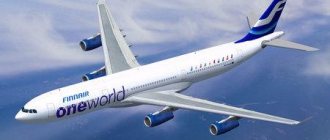Attack aircraft and bombers | USSR
AR-2 bomber
A medium dive bomber of an all-metal design was developed by the Arkhangelsk Design Bureau in 1940 and was produced in 1940-1941. at Moscow plant No. 22. The aircraft was created by modernizing the SB. A total of 200 cars were produced. Vehicle performance characteristics: length – 12.5 m; height – 3.6 m; wingspan – 18 m; wing area – 48.2 m²; empty weight – 4.5 t, take-off weight – 8.2 t; engines - two M-105R with a power of 1100 hp; volume of fuel tanks – 1.5 thousand liters; maximum speed – 512 km/h, cruising speed – 475 km/h; rate of climb – 765 m/m; practical range – 1,500 km; practical ceiling – 10,500 km; run length – 306 m, run length – 514 m; armament - four 7.62-mm ShKAS machine guns; bomb load - 1.6 tons; crew – 3 people.
DB-A heavy bomber
The aircraft was developed at Moscow Plant No. 22 in 1937 and produced by Kazan Plant No. 124 in 1938-1940. It had a smooth skin, metal propellers with adjustable blade angles on the ground, a retractable tail, semi-retractable main landing gear wheels and a bomb bay measuring 6x2 m. For winter flights, it was possible to attach a ski landing gear. A total of 12 cars were produced. Performance characteristics of the vehicle: length – 24.4 m; wingspan - 39.5 m; wing area – 230 m²; empty weight - 15.4 tons, take-off weight - 21.9 tons; engines - four AM-34RN, 970 hp; fuel tank capacity – 14.6 thousand liters; rate of climb – 135 m/m; maximum speed – 330 km/h; practical range – 4,500 km; practical ceiling – 7,720 m; run length – 400 m, run length – 300 m; armament - 20-mm ShVAK cannon (ammunition - 250 rounds), six 7.62-mm ShKAS machine guns (ammunition - 3000 rounds), bomb load - 6.5 tons; crew – 7 people.
Bomber DB-3
The medium bomber was developed by the Ilyushin Design Bureau in 1935 and was produced in 1938-1939. at the Voronezh plant No. 18, Moscow No. 39 and No. 126 in Komsomolsk-on-Amur. A total of 1,528 vehicles were produced in five production versions. Performance characteristics of the vehicle: length – 14.2 m; height – 4.2 m; wingspan - 21.4 m; wing area – 65.6 m²; empty weight – 4.8 t, take-off weight – 9 t; engines - two M85, M-87A, power 760-950 hp; fuel tank capacity – 810.l; maximum speed – 400-439 km/h, cruising speed – 320 km/h; practical range – 3100-3800 km; practical ceiling – 8,400 – 9,600 m; run length – 200 m, run length – 300 m; armament - three 7.62-mm ShKAS machine guns (ammunition - 2500 rounds), bomb load - 2.5 tons; crew – 3 people.
Bomber Er-2 2AM-37
Bomber - Er-2 2M-30B
Bomber - Er-2 2ACh-30B
The medium bomber was developed by OKB-240 in 1939 and was produced by Voronezh plant No. 18 and Irkutsk plant No. 39 in 1940-1945. in three serial modifications. It was a twin-engine monoplane with a reverse gull wing and became a development of the Stal-7 passenger aircraft. A total of 462 cars were produced. Vehicle performance characteristics: length – 16.2 – 16.7 m; height – 4.8 m; wingspan - 21.7 - 23 m; wing area – 72 – 79 m²; empty weight - 8.9 - 10.8 tons, take-off weight - 13.5 - 18.4 tons; engines – M-105/АБ-37/АЧ-30Б power – 1100/1400/1500 hp; volume of fuel tanks – 5.4 thousand liters; rate of climb – 330 – 455 m/m; maximum speed - 415 - 519 km/h, cruising speed - 330 - 437 km/h; practical range – 2,500 – 5,300 km; practical ceiling – 7,500 – 7,700 m; take-off length – 580 m; armament - two 7.62-mm ShKAS machine guns and a 12.7-mm UBT machine gun or three 12.7-mm UBT machine guns or a 20-mm ShVAK cannon and two 12.7-mm UBT machine guns, bomb load - 3 - 5 tons ; crew – 3 – 5 people.
Sturmovik Il-2M
The attack aircraft was developed by the Ilyushin Design Bureau in 1939 and was produced by aircraft factories No. 1, No. 18 and No. 30 in 1941-1945. based on the BSh-2 aircraft. A total of 36.2 thousand cars were produced in five serial modifications. The aircraft was a low-wing aircraft of mixed design. The hull armor was part of the aircraft's airframe and replaced the frame and skin of the entire nose and middle part of the fuselage. The armored hull covered the engine, cockpit and radiators. The transparent frontal armor of the cockpit visor was 64 mm thick and could withstand a 7.62 mm armor-piercing bullet. At the end of 1942, the aircraft became a two-seater, however, the gunner was located outside the armored hull and was protected only by a 6-mm armor plate on the tail side. Vehicle performance characteristics: length – 11.6 m; height – 4.2 m; wingspan - 14.6 m; wing area – 38.5 m²; empty weight - 4 - 4.6 tons, take-off weight - 5.3 - 6.4 tons; armor weight – 1 t; engine – AM-38/38F, power – 1,575 – 1,760 hp; rate of climb – 7 – 10.4 m/s; maximum speed – 390 – 460 km/h; practical range - 630 - 765 km; practical ceiling – 5,500 – 7,800 m; run length - 370 - 450 m, run length - 400 - 535 m; armament - two 20-mm ShVAK cannons (420 rounds) or two 23-mm VYA-23 cannons (300 rounds) or two 37-mm NS-37 cannons (100 rounds), two 7.62-mm ShKAS machine guns (1,500 cartridges), additional 12.7 mm UBT machine gun (500 cartridges); bomb load - 0.6 t; suspended weapons - four to eight RS-82 or RS-132; crew – 1-2 people.
Il-4 bomber
The medium bomber was developed by the Ilyushin Design Bureau in 1940 and was produced in 1942-1944. It was a modified DB-3, which had a new navigator's cabin and a new fuselage. There are two known serial modifications: Il-4T (torpedo bomber) and Il-4TK (high-altitude version). A total of 5.3 thousand cars were produced. Performance characteristics of the vehicle: length – 14.8 m; height – 4.1 m; wingspan - 21.4 m; wing area – 66.7 m²; empty weight – 5.8 t, take-off weight – 12.1 t; engines – M-88B, 1,100 hp; fuel mass - 1.1 thousand tons; rate of climb – 4.4 m/s; maximum speed – 430 km/h; flight range – 3,800 km; practical ceiling – 8,900 m; armament - two 7.62 mm ShKAS machine guns, additionally a 12.7 mm UBT machine gun; bomb load - 2.5 tons; crew – 4 people.
Sturmovik Il-10
The aircraft was developed by the Ilyushin Design Bureau on the basis of the Il-2 in 1944 and was produced since 1944 at aircraft factories No. 1, No. 18 and No. 64. It differed from its predecessor in the armoring of the gunner’s cockpit and the strengthening of defensive weapons. A total of 5 thousand cars were produced, incl. 280 training IL-10. Performance characteristics of the vehicle: length – 11.1 m; height – 4.2 m; wingspan - 13.4 m; wing area – 30 m²; empty weight – 4.6 t, take-off weight – 6.5 t; armor weight – 1 t; engine – AM-42 power – 2,000 hp; rate of climb – 625 m/m; maximum speed – 551 km/h, cruising speed – 436 km/h; practical range – 800 km; practical ceiling – 7,250 m; run length – 475 m, run length – 460 m; armament - two 23-mm VYa-23 cannons (300 rounds) or 20-mm UB-20 cannons and two 7.62-mm ShKAS machine guns, bomb load - 0.6 tons; suspended weapons - eight RS-82 or RS-132; crew – 2 people.
Pe-2 dive bomber
The medium bomber was developed by the Petlyakov Design Bureau in 1940 on the basis of the experimental “100” fighter and was produced in 1940-1945. at plants No. 22, No. 39, No. 124 and No. 125. A total of 11.4 thousand cars were produced in 21 serial modifications. Vehicle performance characteristics: length – 12.2 – 12.8 m; height - 3.4 - 3.9 m; wingspan - 17.1 - 17.5 m; wing area – 40.5 m²; empty weight – 5.8 – 6.2 t, take-off weight – 7.5 – 8.7 t; engines - two M-105R/M-105RA/M-105PF with a power of 1,100 - 1,210 hp; volume of fuel tanks - 1.1 - 1.5 thousand liters; rate of climb – 9.8 m/s; maximum speed – 452 – 530 km/h; practical ceiling – 8,800 m; practical range – 1,200 – 1,500 km; armament - one or two 7.62-mm ShKAS machine guns and three 12.7-mm UBT machine guns, additionally - a DAG-10 grenade launcher; bomb load – 0.6 t, external load – 0.4 t; crew - 2 - 3 people.
Bomber Pe-8 (TB-7/ANT-42)
The long-range heavy bomber was developed by the Tupolev Design Bureau and was produced from 1939 to 1944. Kazan aircraft plant No. 124. It was an all-metal four-engine mid-wing with a smooth skin. The plane had a two-story cabin, armored seats for pilots and gunners in engine nacelles. A total of 93 cars were produced. Vehicle performance characteristics: length – 23.6 m; height – 6.2 m; wingspan – 39 m; wing area – 188.7 m²; empty weight – 20 t, take-off weight – 35 t; engines - four AM-35A/M-30/M-82FN/M-105 with a power of 1,200 - 1,350 hp; rate of climb – 5.9 m/s; volume of fuel tanks – 17 thousand liters; maximum speed – 443 km/h, cruising speed – 400 km/h; practical range – 3,600 – 5,800 km; practical ceiling – 9,300 m; run length – 2,300 m, run length – 580 m; armament - two 20-mm ShVAK cannons, two 12.7-mm UBT machine guns, two 7.62-mm ShKAS machine guns; bomb load - 4 - 5 tons; crew – 8 – 12 people.
Light bomber R-5Sh
The aircraft was developed in 1928 by the Polikarpov Design Bureau and was produced in 1929-1935. at aircraft factory No. 31. It was a single-column braced two-seater sesquiplane made of pine, plywood, canvas and mild steel using welding. There is a known modification with six ShKAS machine guns. A total of 6 thousand vehicles were produced, but no more than 200 vehicles took part in hostilities. Vehicle performance characteristics: length – 10.6 m; height – 2.6 m; wingspan - 15.3 m; wing area – 50.2 m²; empty weight – 3.2 t, take-off weight – 3.8 t; engine – M-17F with a power of 680 hp; rate of climb – 295 m/m; maximum speed – 235 km/h; practical range – 1,000 km; practical ceiling – 6,400 m; run length – 300 m, run length – 220 m; armament - eight to ten 7.62 mm PV-1 machine guns; bomb load - 0.5 t; crew – 2 people.
R-Z attack aircraft
The aircraft was developed by the Polikarpov Design Bureau in 1935 on the basis of the R-5. It was produced by aircraft factory No. 1 in 1936-1937. A total of 1,031 cars were produced. Vehicle performance characteristics: length – 9.7 m; height – 3.5 m; wingspan - 15.5 m; wing area – 42.5 m²; empty weight – 2 t, take-off weight – 3.2 t; engine – M-34N/M-34NV with a power of 850 hp; rate of climb – 425 m/m; maximum speed – 316 km/s, cruising speed – 266 km/h; practical range – 1,000 km; practical ceiling – 8,700 m; armament - five 7.62 mm ShKAS and one PV-1; bomb load - 0.5 t; crew – 2 people.
Bomber SB (ANT-40)
The high-speed medium bomber was developed by the Tupolev Design Bureau in 1934 and was produced by Moscow Plant No. 22 and Irkutsk Plant No. 125 in 1936-1941. There are 14 known modifications of the aircraft, 9 of which were mass-produced. A total of 6.7 thousand cars were produced. Performance characteristics of the vehicle: length – 12.8 m; height – 3.5 m; wingspan - 20.3 m; wing area – 56.7 m²; empty weight – 4.8 t, take-off weight – 7.9 t; engines - two M-103 with a power of 960 hp; maximum speed – 450 km/h, cruising speed – 375 km/h; rate of climb – 9.5 m/s; practical range – 2,300 km; practical ceiling – 7,800 m; run length – 300 m, run length – 350 m; armament - six 7.62-mm ShKAS machine guns; bomb load - 0.6 t; crew – 3 people.
Light bomber Su-2 (BB-1)
The short-range bomber was developed by the Sukhoi Design Bureau in 1939 and produced by aircraft factories No. 135 and No. 207 in 1939-1941. It had a mixed design, a closed cabin with a sliding canopy. To ensure winter operation, all production aircraft were equipped with a set of skis. There are known modifications of the aircraft under the designation SU-4 and ShB. A total of 893 cars were produced. The aircraft were also used as reconnaissance aircraft, spotters and attack aircraft. Performance characteristics of the vehicle: length – 10.3 m; height – 4 m; wingspan - 14.3 m; wing area – 29 m²; empty weight – 3.2 t, take-off weight – 4.7 t; engines – M-82, M-88, M-88B, power 1,330 hp; rate of climb – 558 m/m; volume of fuel tanks – 930.l; maximum speed – 486 km/h, cruising speed – 459 km/h; practical range – 910 km; practical ceiling – 8,400 m; run length – 200 m, run length – 300 m; armament - three ShKAS machine guns; ammunition - 2,000 rounds; bomb load - 0.4 t; outboard weapons - 10 NURS RS-82 or RS-132; crew – 2 people.
Su-6 M-71F attack aircraft
The two-seat armored attack aircraft was developed by the Sukhoi Design Bureau in 1940. The aircraft had a wooden fuselage with a metal wing and a retractable landing gear. In 1940-1944, 10 aircraft with various weapons and engines were produced. Vehicle performance characteristics: length – 9.2 m; height – 4.2 m; wingspan - 13.6 m; wing area – 26 m²; empty weight – 4.1 t, take-off weight – 6.2 t; engines - M-71F, power 1,900 - 2,200 hp; fuel tank volume – 645 l; maximum speed – 514 km/h; practical range - 932 km; practical ceiling – 8,100 m; run length – 410 m, run length – 730 m; armament - two 37-mm NS-37 cannons, two ShKAS machine guns, 12.7-mm UBT machine gun; ammunition - 1,500 rounds; bomb load - 0.4 t; outboard weapons - 10 RS-82 or RS-132; crew – 2 people.
Heavy bomber TB-3 (ANT-6)
The bomber was developed by the Tupolev Design Bureau on the basis of the TB-1 in 1930 and was produced by Voronezh plant No. 18 and Moscow No. 22 and No. 39 in 1932-1937. The aircraft was also used as a transport and landing vehicle. Nine modifications are known, differing in engines, chassis, propellers and trim. A total of 819 vehicles were produced. Performance characteristics of the vehicle: length – 24.4 m; height – 8.5 m; wingspan – 39.5-41.9 m; wing area – 230-234.5 m²; empty weight – 11 t, take-off weight – 19.5 t; engines - four M-17F or M-34/34R with a power of 715-900 hp; volume of fuel tanks – 8 thousand liters; maximum speed – 245-300 km/h, cruising speed – 182 km/h; practical range - 3120 km; practical ceiling – 4,300-8,116 m; run length – 200 m, run length – 300 m; armament - 4-8 7.62 mm machine guns YES; ammunition - 6,300 rounds; bomb load - 3-5 tons; crew – 6-8 people.
Tu-2 dive bomber (ANT-58)
The aircraft was developed by the Tupolev Design Bureau and was produced since 1942 by aircraft factories No. 22 and No. 166. It was an all-metal high-wing aircraft with a two-fin tail, a wing of a caisson structure with flaps and brake grilles. A total of 2.5 thousand vehicles were built in the following serial modifications: Tu-2 (with M-82 engines), Tu-2S (with ASh-82FN engines), Tu-2D (M-82FN), Tu-2T (torpedo bomber) , Tu-2F and Tu-2R (reconnaissance). Performance characteristics of the vehicle: length – 13.8 m; height – 4.1 m; wingspan - 18.9 m; wing area – 48.5 m²; empty weight - 7.6 tons, take-off weight - 11.8 tons; engines - two ASh-82/M-82A with a power of 1,850 hp; rate of climb – 490 m/m; volume of fuel tanks – 2.2 thousand liters; maximum speed – 521 km/h, cruising speed – 442 km/h; practical range – 2,020 km; practical ceiling – 9,000 m; armament - two 20-mm ShVAK cannons (ammunition - 300 rounds), a 12.7-mm UBT machine gun (750 rounds), three 7.62-mm ShKAS machine guns (2,250 rounds); bomb load - 3 tons; external suspension – 10 RS-132; crew – 4 people.
Multipurpose biplane U-2/Po-2
The aircraft was created under the leadership of N. N. Polikarpov in 1928. and was produced since 1929 in the following serial modifications: U-2LSh (attack aircraft with one 7.62-mm ShKAS machine gun, mount for 120 kg bombs and guides for four RS-82); U-2LNB (night bomber); U-2VS or Po-2VS (combat training); U-2M (seaplane); U-2S (S-1) and S-2 (sanitary), U-2SP (communications aircraft), U-2UT (trainer). Since 1941, the aircraft was produced at factories No. 51, No. 387, No. 464, No. 471 and No. 494. It was a biplane with an air-cooled engine. The structure was made of pine and plywood, with fabric sheathing, and the components were made of mild steel. Since 1944 it received the designation Po-2. A total of 33 thousand cars were produced. Vehicle performance characteristics: length – 8.2 m; height – 3.1 m; wingspan - 11.4 m; wing area – 33.2 m²; empty weight - 635 - 750 kg, take-off weight - 890 - 910 kg; engine - M-11/M-11A/M-11D, power - 100 - 115 hp; rate of climb – 40 m/m; maximum speed - 130 - 150 km/h, cruising speed - 100 - 120 km/h; practical ceiling - 1,500 - 3,800 m; practical range - 430 - 530 km; run length – 100 m, run length – 150 m; armament - 7.62 mm ShKAS or DA machine gun (ammunition - 200 rounds); bomb load - 100 - 500 kg; crew 2 people.
Yak-1 attack aircraft
The aircraft was produced in 1941-1942. A total of 1.1 thousand cars were produced. Vehicle performance characteristics: length – 8.5 m; wingspan – 10 m; wing area – 17.2 m²; empty weight – 2.5 t, take-off weight – 3 t; engine - M-105PA power - 1050 hp; rate of climb – 806 m/m; maximum speed – 528 km/h; practical ceiling – 9,500 m; practical range – 760 km; run length – 100 m, run length – 150 m; armament - 20-mm ShVAK cannon and two 7.62-mm ShKAS machine guns; bomb load - 200 kg or six RS-82 launchers; crew 1 person.
Light bomber Yak-2
The bomber was developed by the Yakovlev Design Bureau in 1939 and was produced in 1939-1940. A total of 111 vehicles were produced. Vehicle performance characteristics: length – 9.3 m; wingspan – 14 m; wing area – 29 m²; empty weight – 4 t, take-off weight – 5.4 t; engines - two M-103, 960 hp; rate of climb – 10.8 m/s; maximum speed – 515 km/h; practical range – 800 km; practical ceiling – 8,900 m; armament - 7.62 mm ShKAS machine gun, bomb load - 0.9 tons; crew - 2 - 3 people.
Short-range bomber Yak-4
The light bomber was developed by the Yakovlev Design Bureau on the basis of the Yak-2 and was produced in 1940-1942. A total of 90 cars were produced. Vehicle performance characteristics: length – 10.2 m; wingspan – 14 m; wing area – 29 m²; empty weight – 4 t, take-off weight – 5.8 t; engines - two M-105, 1,100 hp; fuel tank capacity – 960 l; rate of climb – 15.3 m/s; maximum speed – 574 km/h, cruising speed – 545 km/h; practical range – 1200 km; practical ceiling – 10,000 m; armament - two 7.62-mm ShKAS machine guns, bomb load - 0.8 tons; crew – 2 people.
Share to:
Modifications of IL-2
Throughout its “biography,” the armored attack aircraft was repeatedly modernized and rearmed.
Il-2 with NS-37 guns. It was assumed that such an aircraft would be able to effectively destroy tanks
The following modifications of this aircraft are known:
- Single seat Il-2 (TsKB-57). The first production version of the attack aircraft. Some of these aircraft were converted into two-seaters directly by the troops, using artisanal methods;
- Double IL-2. Produced starting in the autumn of 1942. The engine remained the same - AM-38, which caused a significant decrease in the maneuverability of the aircraft. In particular, the turn execution time increased to 49 seconds. The gunner's cockpit and turret caused criticism until the end of the war, however, it turned out to be impossible to improve them without stopping mass production;
- Il-2 AM-38F. Serial production of this modification began in January 1943. The two-seat aircraft is equipped with a souped-up engine, which made it possible to bring its main characteristics to the same level as those of a single-seat attack aircraft;
- Il-2 “wing with arrow”, abbreviated as KSS, sometimes referred to as Il-2 M3. A large-scale modification with a significantly modified wing shape and therefore improved alignment. In addition, the aerodynamic characteristics of the aircraft were improved, and fiber tanks were installed instead of the previous metal tanks. The main advantage of these containers was their ability to self-heal - small holes were repaired with a special composition that hardened upon contact with air;
- IL-2 NS-37. This version of the attack aircraft was equipped with two NS-37 guns with a caliber of 37 mm instead of VYA-23 cannons. The ammunition load was 50 shells per barrel. These guns were quite bulky and heavy, which led to a significant reduction in the bomb load and maximum speed of the attack aircraft. More than a thousand of these Ilovs were built. They tried to use them against German tanks, but practice has shown that the best weapon for destroying armored vehicles is not cannons, but PTAB aerial bombs;
- IL-2KR. This aircraft was equipped with a camera mounted in the rear of the fuselage and a special walkie-talkie, the antenna of which was mounted on the cockpit. The main purpose of the IL-2KR is artillery fire adjustment and photo reconnaissance.
A modern drawing depicting a “hypothetical” non-serial modification of the Il-2T.
There were several non-serial modifications of the attack aircraft:
- IL-2 NS-45. Another attempt to create an “anti-tank aircraft”. Aircraft guns designed by Nudelman and Suraev with a caliber of 45 mm were installed on the wing. Tests have shown that the recoil of this gun is poorly perceived by the aircraft, and aimed shooting is almost impossible;
- Il-2 ShFK-37. The result of a conversion of the original single-seat attack aircraft. The aircraft was armed with two ShFK-37 wing cannons of 37 mm caliber. The attack aircraft received some experience in combat use in December 1942 and January 1943, but did not go into production;
- IL-2I. The model was created in 1943 under the impression of the use of serial Il-2s against German transport aviation, which was trying to create an “air bridge” with an encircled group of German troops near Stalingrad. The plane again became a single-seater, it was made as light as possible, even the wing ShKAS machine guns were removed. But the “fighter-bomber” did not work out - the speed of the car was insufficient;
- IL-2 M-82. An experimental aircraft, on which an M-82 air-cooled engine was installed instead of the AM-38 engine. The characteristics of the attack aircraft generally remained the same, however, this version was not mass-produced;
- IL-2T. There are no documents confirming the very existence of this modification. According to unconfirmed information, the wing cannons were removed from the Il-2 KSS aircraft, and a 45-36AN torpedo was somehow suspended under the fuselage.
“Bomber Fighter” Il-2I
It is also worth mentioning the training modification of the Il-2U. An instructor was located in the rear cockpit of this aircraft, who had the ability to use backup backup control. Such an attack aircraft could carry no more than 200 kg of bombs, two rockets, and only machine guns were left as small arms.
